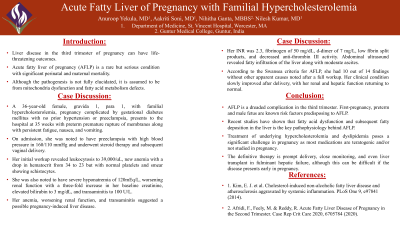Tuesday Poster Session
Category: Liver
P4011 - Acute Fatty Liver of Pregnancy in a Patient With Familial Hypercholesterolemia
Tuesday, October 24, 2023
10:30 AM - 4:00 PM PT
Location: Exhibit Hall

Has Audio

Anuroop Yekula, MD
Saint Vincent Hospital
Worcester, MA
Presenting Author(s)
Anuroop Yekula, MD1, Aakriti Soni, MD1, Nihitha Ganta, MBBS2, Nilesh Kumar, MD1
1Saint Vincent Hospital, Worcester, MA; 2Guntur Medical College, Guntur, Andhra Pradesh, India
Introduction: Liver disease in the third trimester of pregnancy can have life-threatening outcomes. Acute fatty liver of pregnancy (AFLP) is a rare but serious condition with significant perinatal and maternal mortality. Although the pathogenesis is not fully elucidated, it is assumed to be from mitochondria dysfunction and fatty acid metabolism defects.
Case Description/Methods: A 36-year-old female, gravida 1, para 1, with familial hypercholesterolemia, pregnancy complicated by gestational diabetes mellitus with no prior hypertension or preeclampsia, presents to the hospital at 35 weeks with preterm premature rupture of membranes along with persistent fatigue, nausea, and vomitings.
On admission, she was noted to have preeclampsia with high blood pressure in 160/110 mmHg and underwent steroid therapy and subsequent vaginal delivery. Her initial workup revealed leukocytosis to 39,000/uL, new anemia with a drop in hematocrit from 34 to 23 but with normal platelets and smear showing schistocytes initially. She was also noted to have severe hyponatremia of 120mEq/L, worsening renal function with a three-fold increase in her baseline creatinine, elevated bilirubin to 3 mg/dL, and transaminitis to 100 U/L. Her anemia, worsening renal function, and transaminitis suggested a possible pregnancy-induced liver disease. Her INR was 2.3, fibrinogen of 50 mg/dL, d-dimer of 7 mg/L, low fibrin split products, and decreased anti-thrombin III activity. Abdominal ultrasound revealed fatty infiltration of the liver along with moderate ascites.
She was transferred to the medical critical care unit for close monitoring. According to the Swansea criteria for AFLP, she had 10 out of 14 findings without other apparent causes noted after a full workup. Her clinical condition slowly improved after delivery, with her renal and hepatic function returning to normal.
Discussion: AFLP is a dreaded complication in the third trimester. First-pregnancy, preterm and male fetus are known risk factors predisposing to AFLP. Recent studies have shown that fatty acid dysfunction and subsequent fatty deposition in the liver is the key pathophysiology behind AFLP. Treatment of underlying hypercholesterolemia and dyslipidemia poses a significant challenge in pregnancy as most medications are teratogenic and/or not studied in pregnancy. The definitive therapy is prompt delivery, close monitoring, and even liver transplant in fulminant hepatic failure, although this can be difficult if the disease presents early in pregnancy.
Disclosures:
Anuroop Yekula, MD1, Aakriti Soni, MD1, Nihitha Ganta, MBBS2, Nilesh Kumar, MD1. P4011 - Acute Fatty Liver of Pregnancy in a Patient With Familial Hypercholesterolemia, ACG 2023 Annual Scientific Meeting Abstracts. Vancouver, BC, Canada: American College of Gastroenterology.
1Saint Vincent Hospital, Worcester, MA; 2Guntur Medical College, Guntur, Andhra Pradesh, India
Introduction: Liver disease in the third trimester of pregnancy can have life-threatening outcomes. Acute fatty liver of pregnancy (AFLP) is a rare but serious condition with significant perinatal and maternal mortality. Although the pathogenesis is not fully elucidated, it is assumed to be from mitochondria dysfunction and fatty acid metabolism defects.
Case Description/Methods: A 36-year-old female, gravida 1, para 1, with familial hypercholesterolemia, pregnancy complicated by gestational diabetes mellitus with no prior hypertension or preeclampsia, presents to the hospital at 35 weeks with preterm premature rupture of membranes along with persistent fatigue, nausea, and vomitings.
On admission, she was noted to have preeclampsia with high blood pressure in 160/110 mmHg and underwent steroid therapy and subsequent vaginal delivery. Her initial workup revealed leukocytosis to 39,000/uL, new anemia with a drop in hematocrit from 34 to 23 but with normal platelets and smear showing schistocytes initially. She was also noted to have severe hyponatremia of 120mEq/L, worsening renal function with a three-fold increase in her baseline creatinine, elevated bilirubin to 3 mg/dL, and transaminitis to 100 U/L. Her anemia, worsening renal function, and transaminitis suggested a possible pregnancy-induced liver disease. Her INR was 2.3, fibrinogen of 50 mg/dL, d-dimer of 7 mg/L, low fibrin split products, and decreased anti-thrombin III activity. Abdominal ultrasound revealed fatty infiltration of the liver along with moderate ascites.
She was transferred to the medical critical care unit for close monitoring. According to the Swansea criteria for AFLP, she had 10 out of 14 findings without other apparent causes noted after a full workup. Her clinical condition slowly improved after delivery, with her renal and hepatic function returning to normal.
Discussion: AFLP is a dreaded complication in the third trimester. First-pregnancy, preterm and male fetus are known risk factors predisposing to AFLP. Recent studies have shown that fatty acid dysfunction and subsequent fatty deposition in the liver is the key pathophysiology behind AFLP. Treatment of underlying hypercholesterolemia and dyslipidemia poses a significant challenge in pregnancy as most medications are teratogenic and/or not studied in pregnancy. The definitive therapy is prompt delivery, close monitoring, and even liver transplant in fulminant hepatic failure, although this can be difficult if the disease presents early in pregnancy.
Disclosures:
Anuroop Yekula indicated no relevant financial relationships.
Aakriti Soni indicated no relevant financial relationships.
Nihitha Ganta indicated no relevant financial relationships.
Nilesh Kumar indicated no relevant financial relationships.
Anuroop Yekula, MD1, Aakriti Soni, MD1, Nihitha Ganta, MBBS2, Nilesh Kumar, MD1. P4011 - Acute Fatty Liver of Pregnancy in a Patient With Familial Hypercholesterolemia, ACG 2023 Annual Scientific Meeting Abstracts. Vancouver, BC, Canada: American College of Gastroenterology.
